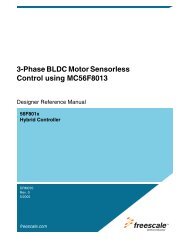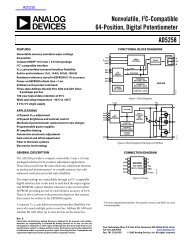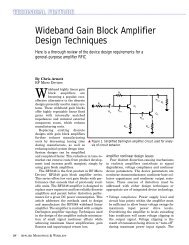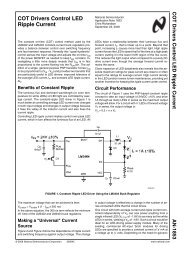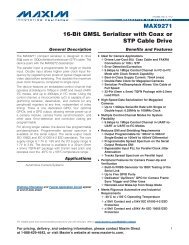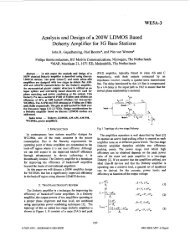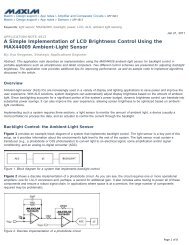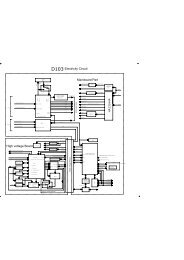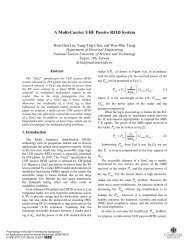MAX9272 28-Bit GMSL Deserializer for Coax or STP Cable
MAX9272 28-Bit GMSL Deserializer for Coax or STP Cable
MAX9272 28-Bit GMSL Deserializer for Coax or STP Cable
Create successful ePaper yourself
Turn your PDF publications into a flip-book with our unique Google optimized e-Paper software.
<strong>MAX9272</strong><br />
<strong>28</strong>-<strong>Bit</strong> <strong>GMSL</strong> <strong>Deserializer</strong> <strong>f<strong>or</strong></strong> <strong>Coax</strong> <strong>or</strong> <strong>STP</strong> <strong>Cable</strong><br />
Applications In<strong>f<strong>or</strong></strong>mation<br />
Err<strong>or</strong> Checking<br />
The deserializer checks the serial link <strong>f<strong>or</strong></strong> err<strong>or</strong>s and<br />
st<strong>or</strong>es the number of detected and c<strong>or</strong>rected err<strong>or</strong>s<br />
in the 8-bit registers, DETERR (0x10) and CORRERR<br />
(0x12). If a large number of 8b/10b err<strong>or</strong>s are detected<br />
within a sh<strong>or</strong>t duration (err<strong>or</strong> rate R 1/4), the deserializer<br />
loses lock and stops the err<strong>or</strong> counter. The deserializer<br />
then attempts to relock to the serial data. DETERR and<br />
CORRERR reset upon successful video link lock, successful<br />
readout of their respective registers (through FC),<br />
<strong>or</strong> whenever autoerr<strong>or</strong> reset is enabled. The deserializer<br />
uses a separate PRBS register during the internal PRBS<br />
test, and DETERR and CORRERR are reset to 0x00.<br />
ERR Output<br />
The deserializer has an open-drain ERR output. This<br />
output asserts low whenever the number of detected/c<strong>or</strong>rected<br />
err<strong>or</strong>s exceeds their respective err<strong>or</strong> thresholds<br />
during n<strong>or</strong>mal operation, <strong>or</strong> when at least one PRBS err<strong>or</strong><br />
is detected during PRBS test. ERR reasserts high whenever<br />
DETERR and CORRERR reset, due to DETERR/<br />
CORRERR readout, video link lock, <strong>or</strong> autoerr<strong>or</strong> reset.<br />
Autoerr<strong>or</strong> Reset<br />
The default method to reset err<strong>or</strong>s is to read the respective<br />
err<strong>or</strong> registers in the deserializer (0x10, 0x12, and<br />
0x13). Autoerr<strong>or</strong> reset clears the err<strong>or</strong> counters DETERR/<br />
CORRERR and the ERR output ~1Fs after ERR goes low.<br />
Autoerr<strong>or</strong> reset is disabled on power-up. Enable autoerr<strong>or</strong><br />
reset through AUTORST (0x08, D2). Autoerr<strong>or</strong> reset<br />
does not run when the device is in PRBS test mode.<br />
Dual µC Control<br />
Usually systems have one FC to run the control channel,<br />
located on the serializer side <strong>f<strong>or</strong></strong> video-display applications<br />
<strong>or</strong> on the deserializer side <strong>f<strong>or</strong></strong> image-sensing<br />
applications. However, a FC can reside on each side<br />
simultaneously and trade off running the control channel.<br />
In this case, each FC can communicate with the serializer<br />
and deserializer and any peripheral devices.<br />
Contention occurs if both FCs attempt to use the control<br />
channel at the same time. It is up to the user to prevent<br />
this contention by implementing a higher-level protocol.<br />
In addition, the control channel does not provide arbitration<br />
between I 2 C masters on both sides of the link. An<br />
acknowledge frame is not generated when communication<br />
fails due to contention. If communication across the<br />
serial link is not required, the FCs can disable the <strong>f<strong>or</strong></strong>ward<br />
and reverse control channel using the FWDCCEN and<br />
REVCCEN bits (0x04, D[1:0]) in the serializer/deserializer.<br />
Communication across the serial link is stopped and<br />
contention between FCs cannot occur.<br />
As an example of dual FC use in an image-sensing application,<br />
the serializer can be in sleep mode and waiting<br />
<strong>f<strong>or</strong></strong> wake-up by the FC on the deserializer side. After<br />
wake-up, the serializer-side FC assumes master control<br />
of the serializer’s registers.<br />
Changing the Clock Frequency<br />
It is recommended that the serial link be enabled after<br />
the video clock (fPCLKOUT) and the control-channel<br />
clock (fUART/fI2C) are stable. When changing the clock<br />
frequency, stop the video clock <strong>f<strong>or</strong></strong> 5Fs, apply the clock<br />
at the new frequency, then restart the serial link <strong>or</strong> toggle<br />
SEREN. On-the-fly changes in clock frequency are possible<br />
if the new frequency is immediately stable and<br />
without glitches. The reverse control channel remains<br />
unavailable <strong>f<strong>or</strong></strong> 350Fs after serial link start <strong>or</strong> stop. When<br />
using the UART interface, limit on-the-fly changes in<br />
fUART to fact<strong>or</strong>s of less than 3.5 at a time to ensure that<br />
the device recognizes the UART sync pattern. F<strong>or</strong> example,<br />
when lowering the UART frequency from 1Mbps to<br />
100kbps, first send data at 333kbps then at 100kbps <strong>f<strong>or</strong></strong><br />
reduction ratios of 3 and 3.333, respectively.<br />
Fast Detection of<br />
Loss-of-Synchronization<br />
A measure of link quality is the recovery time from lossof-synchronization.<br />
The host can be quickly notified of<br />
loss-of-lock by connecting the deserializer’s LOCK output<br />
to the GPI input. If other sources use the GPI input,<br />
such as a touch-screen controller, the FC can implement<br />
a routine to distinguish between interrupts from lossof-sync<br />
and n<strong>or</strong>mal interrupts. Reverse control-channel<br />
communication does not require an active <strong>f<strong>or</strong></strong>ward link<br />
to operate and accurately tracks the LOCK status of the<br />
<strong>GMSL</strong> link. LOCK asserts <strong>f<strong>or</strong></strong> video link only and not <strong>f<strong>or</strong></strong><br />
the configuration link.<br />
36


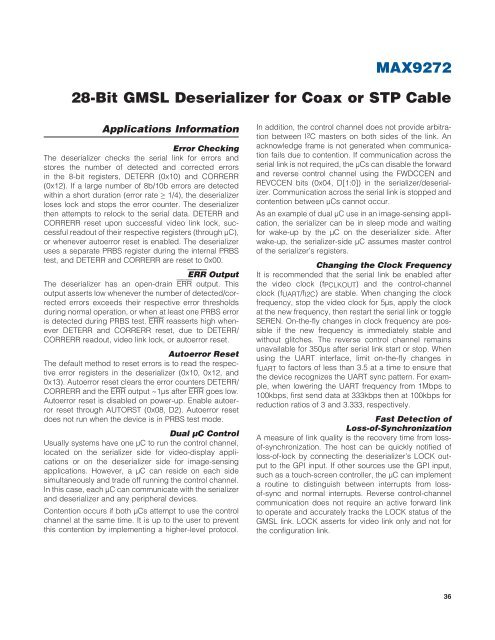

![P-CAD EDA - [Sheet1]](https://img.yumpu.com/49470492/1/190x115/p-cad-eda-sheet1.jpg?quality=85)
